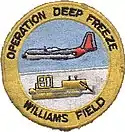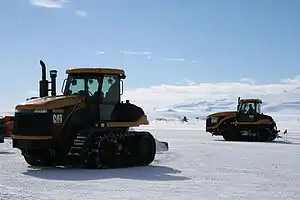Williams Field
Williams Field or Willy Field (ICAO: NZWD) is a United States Antarctic Program airfield in Antarctica. Williams Field consists of two snow runways located on approximately 8 meters (25 ft) of compacted snow, lying on top of 8–10 ft of ice,[3] floating over 550 meters (1,800 ft) of water.[4] The airport, which is approximately seven miles from Ross Island, serves McMurdo Station and New Zealand's Scott Base. Until the 2009–10 summer season, Williams was the major airfield for on-continent aircraft operations in Antarctica.
Williams Field | |||||||||||||||
|---|---|---|---|---|---|---|---|---|---|---|---|---|---|---|---|
 | |||||||||||||||
| Summary | |||||||||||||||
| Airport type | Public | ||||||||||||||
| Location | McMurdo Station, Antarctica | ||||||||||||||
| Elevation AMSL | 68 ft / 21 m | ||||||||||||||
| Coordinates | 77°52′03″S 167°03′24″E | ||||||||||||||
| Map | |||||||||||||||
 NZWD Location of airfield in Antarctica | |||||||||||||||
| Runways | |||||||||||||||
| |||||||||||||||
Williams Field is named in honor of Richard T. Williams, a United States Navy equipment operator who drowned when his D-8 tractor broke through the ice on January 6, 1956. Williams and other personnel were participants in the first Operation Deep Freeze, a U.S. military mission to build a permanent science research station at McMurdo Station in anticipation of the International Geophysical Year 1957–58.
Operation


The skiway was typically in operation from December through to the end of February. Other McMurdo Station airfields include the Ice Runway (October to December) and Phoenix Airfield.[5]
The Williams Field snow runway is known locally as "Willy's Field". The airfield is a groomed snow surface that can support ski-equipped aircraft landings only. A cluster of facilities for flight operations, referred to as "Willy Town", includes several rows of containers for workers and a galley. Willy Field Tavern, a bar at the airfield, closed in 1994.
Air Traffic Control services are provided by Williams Tower / Approach (Willie Tower), and by McMurdo Center (Mac Center) when the tower is closed. The McMurdo Weather Office provides weather forecasting for Williams Field while onsite Controllers and Weather Observers provide hourly and special weather observations.
Aviation fuel at Williams Field is pumped in a 16 km (10 mi) flexible pipe from McMurdo Station. Fuel is stored in up to 12 tanks. The fuel tanks, like other structures at the airfield, are mounted on skis or runners for portability.[6] Generator and heating fuel is delivered to the station by fuel trucks from McMurdo Station, with fuels stored at the individual structures.
The extraordinary conditions encountered at Williams Field include the fact that the airfield is in a continuous slow slide towards the sea. Seaward movement of the floating McMurdo Ice Shelf upon which the airfield is constructed has forced Williams Field to be relocated three times since its original construction. Workers last moved the airfield during the 1984–85 season.[7] Subsequently, personnel housed at Williams lived in buildings constructed on sleds to facilitate relocation. In the past, up to 450 people were housed at the airfield, according to the National Science Foundation. In 1994 the National Science Foundation constructed two dorm buildings at McMurdo Station and began transporting personnel to Williams Field using various vehicles including Foremost Delta II and Ford E-350 vans.
Current aircraft in use
Historical notes

- 1957: Pan American Boeing 377 Stratocruiser makes round trip from Christchurch to McMurdo Sound. First civilian flight to Antarctica.
- 1960: U.S. Navy WV-2 BuNo 126513 crashes after landing short of the ice runway.
- 1960: First ski-equipped C-130 Hercules cargo aircraft lands in Antarctica.
- 1960: Sunspots knock out radio communications for eight days, forcing cancellation of all flights between New Zealand and McMurdo.
- 1966: First all-jet aircraft (USAF-C-141) lands at Williams.
- 1967: Earliest scheduled winter fly-in.
- 1970: U.S. Navy "Pegasus" C-121J crash lands. Aircraft is destroyed but no fatalities among the 80 persons aboard. Pegasus Field is named after this aircraft.
- 1979: Air New Zealand Flight 901 crashes on nearby Mt Erebus. 257 people died.
See also
Notes
- Airport information for NZWD at World Aero Data. Data current as of October 2006.Source: DAFIF.
- Airport information for NZWD at Great Circle Mapper. Source: DAFIF (effective October 2006).
- Minneci, Beth (17 December 2000). "There's potential at Pegasus" (PDF). AntarcticSun.USAP.gov. Archived (PDF) from the original on 22 December 2017. Retrieved 7 November 2016.
- Antarctic Photo Library U.S. Antarctic Program at the Wayback Machine (archived 2007-02-22)
- , Interagency Air Operations Manual]. United States Antarctic Program, September 2016.
- Planning and Hazards of Spill Response in Antarctica. Archived 2006-10-30 at the Wayback Machine Erich R. Gundlach, E-Tech International, Inc.; John J. Gallagher Gallagher, Marine Systems, Inc.; John Hatcher and Tom Vinson, Raytheon Polar Services Company. 2001 International Oil Spill Conference.
- Berthing at McMurdo for Williams Field, Office of Polar Programs; National Science Foundation. August 19, 1993.
References
- Change of Command pamphlet. U.S. Naval Support Force Antarctica; June 10, 1991.
- Clarke, Peter; On the Ice. Rand McNally & Company, 1966.
- Ice can give airmen that sinking feeling, The NewsTribune.com. Tacoma, Wash.; November 20, 2006.
- McMurdo 1960 Crash
- United States Antarctic Research Program Calendars: 1983, 1985.
- Where danger and wonder collide, The NewsTribune.com. Tacoma, Wash.; November 20, 2006.
External links
| Wikimedia Commons has media related to Williams Field (Antarctica). |
- Aircraft of Antarctica
- Moving the Airport, December 21, 1999.
- List of stratospheric balloon launches under NASA's Long Duration Balloon program
- Current weather for NZWD at NOAA/NWS
.svg.png.webp)